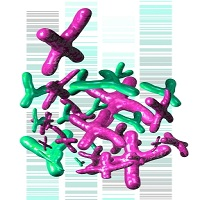Regulatory T Cells and Ocular Graft Versus Host Disease: A Novel Treatment Approach
Medical hypothesis discovery and innovation in ophthalmology,
Vol. 7 No. 3 (2018),
1 September 2018
,
Page 119-121
Abstract
Graft Versus Host Disease (GVHD) is an inflammatory immune disease, mediated by the donor’s immune cells and can arise after allogeneic Hematopoietic Stem Cell Transplantation (HSCT) for the treatment of hematologic malignancies. It can lead to destructive manifestations in various tissues, particularly dermatological, gastrointestinal, and ocular tissues. The most common ocular morbidity is dry eyes, which is often the first manifestation of GVHD. Regulatory T cells (Tr) can be broadly classified as natural or adaptive (induced). After Bone-Marrow Transplantation (BMT), excessively increased levels of type 1 Tr (Tr1) are generally observed with absence of a GVHD, while low levels are seen with severe GVHD. Treatment of patients, undergoing BMT with Interleukin-10 (IL-10)-anergized donor T cells, led to immune reconstitution without the development of GVHD, which resulted in protection against infection and against the return of the cancer. Surprisingly, in both naive syngeneic mouse models of skin and cardiac allografts, graft retention was augmented after infusion of in vitro generated double-negative Tr (DN Tr). In addition, GVHD was reduced in mice with a genetic deficiency in the IL-27 receptor (IL-27R-/-) and in mice treated with anti-IL-27p28–specific antibody. Considering above mentioned findings we would suggest carrying out experiments, using animal models of GVHD, in order to evaluate the potential role of Tr, as an innovative approach to overcome severe ocular morbidity caused by ocular GVHD.
References
Filipovich AH, Weisdorf D, Pavletic S, Socie G, Wingard JR, Lee SJ, et al. National Institutes of Health consensus development project on criteria for clinical trials in chronic graft-versus-host disease: I. Diagnosis and staging working group report. Biol Blood Marrow Transplant. 2005;11(12):945-56. doi: 10.1016/j.bbmt.2005.09.004 pmid: 16338616
Mirza N, Zierhut M, Korn A, Bornemann A, Vogel W, Schmid-Horch B, et al. Graft versus self (GvS) against T-cell autoantigens is a mechanism of graft-host interaction. Proc Natl Acad Sci U S A. 2016;113(48):13827-32. doi: 10.1073/pnas.1609118113 pmid: 27834728
Ferrara JL, Levine JE, Reddy P, Holler E. Graft-versus-host disease. Lancet. 2009;373(9674):1550-61. doi: 10.1016/S0140-6736(09)60237-3 pmid: 19282026
Anderson NG, Regillo C. Ocular manifestations of graft versus host disease. Curr Opin Ophthalmol. 2004;15(6):503-7. pmid: 15523196
Socie G, Ritz J. Current issues in chronic graft-versus-host disease. Blood. 2014;124(3):374-84. doi: 10.1182/blood-2014-01-514752 pmid: 24914139
Blaise D, Kuentz M, Fortanier C, Bourhis JH, Milpied N, Sutton L, et al. Randomized trial of bone marrow versus lenograstim-primed blood cell allogeneic transplantation in patients with early-stage leukemia: a report from the Societe Francaise de Greffe de Moelle. J Clin Oncol. 2000;18(3):537-46. doi: 10.1200/JCO.2000.18.3.537 pmid: 10653869
Mohty M, Kuentz M, Michallet M, Bourhis JH, Milpied N, Sutton L, et al. Chronic graft-versus-host disease after allogeneic blood stem cell transplantation: long-term results of a randomized study. Blood. 2002;100(9):3128-34. doi: 10.1182/blood.V100.9.3128 pmid: 12384409
Ogawa Y, Okamoto S, Wakui M, Watanabe R, Yamada M, Yoshino M, et al. Dry eye after haematopoietic stem cell transplantation. Br J Ophthalmol. 1999;83(10):1125-30. pmid: 10502571
Li Z, Li D, Tsun A, Li B. FOXP3+ regulatory T cells and their functional regulation. Cell Mol Immunol. 2015;12(5):558-65. doi: 10.1038/cmi.2015.10 pmid: 25683611
Shalev I, Schmelzle M, Robson SC, Levy G. Making sense of regulatory T cell suppressive function. Semin Immunol. 2011;23(4):282-92. doi: 10.1016/j.smim.2011.04.003 pmid: 21592823
Zhang ZX, Yang L, Young KJ, DuTemple B, Zhang L. Identification of a previously unknown antigen-specific regulatory T cell and its mechanism of suppression. Nat Med. 2000;6(7):782-9. doi: 10.1038/77513 pmid: 10888927
Chen W, Ford MS, Young KJ, Zhang L. Infusion of in vitro-generated DN T regulatory cells induces permanent cardiac allograft survival in mice. Transplant Proc. 2003;35(7):2479-80. pmid: 14611991
Belle L, Agle K, Zhou V, Yin-Yuan C, Komorowski R, Eastwood D, et al. Blockade of interleukin-27 signaling reduces GVHD in mice by augmenting Treg reconstitution and stabilizing Foxp3 expression. Blood. 2016;128(16):2068-82. doi: 10.1182/blood-2016-02-698241 pmid: 27488350
Romano M, Tung SL, Smyth LA, Lombardi G. Treg therapy in transplantation: a general overview. Transpl Int. 2017;30(8):745-53. doi: 10.1111/tri.12909 pmid: 28012226
Zhang L, Yu J, Wei W. Advance in Targeted Immunotherapy for Graft-Versus-Host Disease. Front Immunol. 2018;9:1087. doi: 10.3389/fimmu.2018.01087 pmid: 29868032
- Abstract Viewed: 1249 times
- Full Text PDF Downloaded: 1036 times


